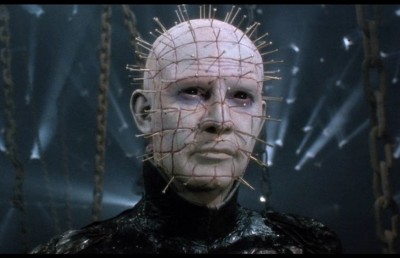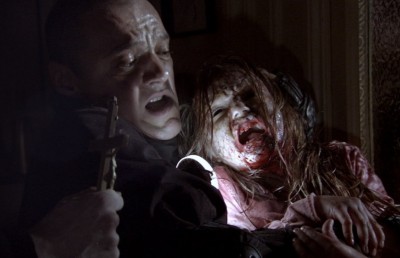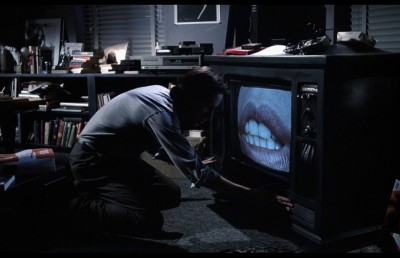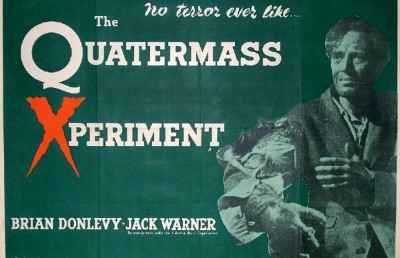In the Folds of the Flesh
A Giallo Rarity
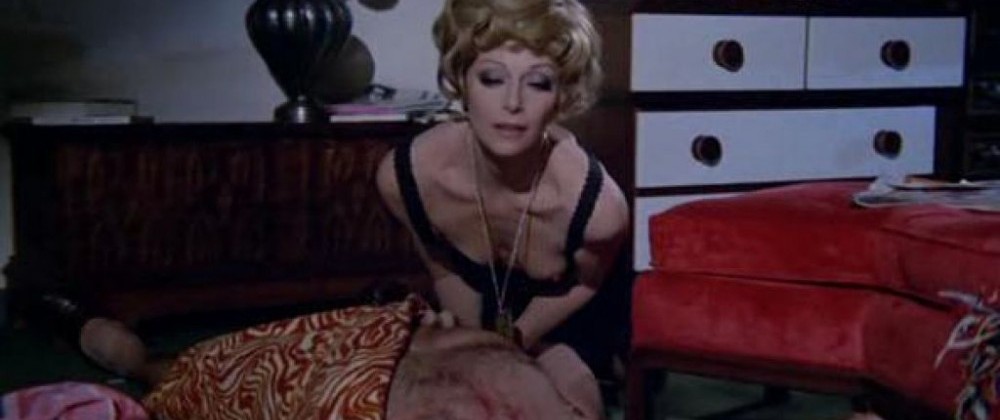
In the Folds of the Flesh (1970, Italian-Spanish, Sergio Bergonzelli) is one of the weirder entries into the giallo genre, which, if you are a fan of this Eurocult genre par excellence, you know is saying a lot! In most respects it deviates from standard “who did it” giallo plot because the mystery is not so much who is the killer (although that is in question), but who is the victim, and why. Where it fits in with giallo decorum, along with its easy on the eyes pop art design and color scheme, is the way the back-story continually thickens with a carousel of revolving (and evolving) characters, plot twists, and subjective flashbacks of the same primal murder scene. Visual (and aural) style is always at a premium in the giallo and In the Folds of the Flesh, though not in the league of a Bava, Freda or Argento, has an arresting visual style marked by stylistic shifts. For example, the flashbacks to the primal scene stand out with a psychedelic styled prism-like splitting of the image in two or three, while other exposition flashbacks are handled in a montage of photographic freeze frames (echoing La Jetée).
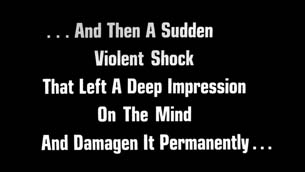
The film takes little time setting up an exposition. Instead it opens with a bang: a frenetic montage which is an immediate response to the title card which reads, “And then a sudden violent shock that left a deep impression on the mind and damagen (sic) it permanently.” Shock comes in the shape of a decapitated head that rolls toward the camera, followed by a static tableau of a boy, mother and blond-haired teen daughter standing looking at the aftermath of a murder by decapitation.
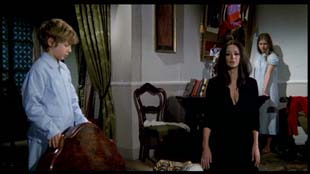
The tableau is framed in a theatrical style, with the boy in the foreground and daughter in the background. This scene will become the ‘primal scene’ or ‘punctum’ 1 which is referenced throughout, with each subsequent flashback to the scene offering –a la ??Rashomon??– a different interpretation of the events. The first ‘explicit’ reading of this scene is the murder of a husband/father by either the wife (Lucille, played by Eleonora Rossi Drago) or young, teenage daughter (Falesse, played for the majority of the film by Anna Maria Pierangeli). As the story develops the plot twists deepen, thicken and practically strangles the viewer into abandoning all reason and submitting to the film’s glorious ‘Freudian’ logic, expressed in the two title cards imaged above.
The opening is intercut with a (poor? See endnote 1) day for night police car chase of a man on a motorcycle. The quarry, Pascal (Fernando Sancho), finds his way onto a villa grounds, where he gets distracted by the sight of a woman, Lucille, setting a yacht adrift at sea and then burying a corpse (we presume the one seen in the primal scene that was rolled in a red carpet). His distraction allows the police to apprehend him, and he stares at the woman while being led away by handcuff, inexplicably keeping silent about her actions. As is if to warn the viewer of what is to come, the film offers a second title card: “What has been remains imbedded in the brain nestled in the folds of the flesh distorted it conditions and subconsciously impels….” (Freud).
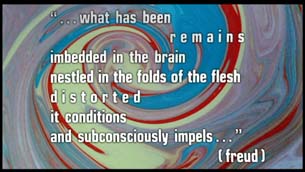
Without notice the film flash forwards thirteen years, to the mother, Lucille (who oddly appears at the same age in present and in flashbacks), son Colin (played by Emilio Gutierrez Caba, whose wardrobe can cause serious eye trauma) and Falesse (Anna Maria Pierangeli). After a series of dizzying twists which will be unraveled below we learn that the real Falesse was traumatized by the primal scene and placed in an insane asylum —justly or not— while the character played by Pierangeli in a blond wig is actually Ester (or Esther), Lucille’s daughter by her first (unnamed) marriage. The real Falesse (blond-haired Rosa Schlauza), Lucille’s daughter with her second husband André, has been kept locked away in a psychiatric ward and deprived of her rightful legal inheritance of André’s estate.
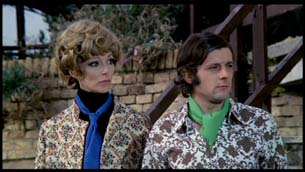
For the next twenty or so minutes the villa is visited by a series of males who promptly become Falesse’s next victim. Falesse, who believes she murdered her father thirteen years ago, and was sexually abused, copes with the traumatic experience of patricide by replaying the decapitation with each new visitor. Colin, an artist who treats murder as an art (a giallo theme), encourages Falesse’s ‘therapy’ and refers to her as a ‘praying mantis.’ The first victim is a man who claims to be a cousin, Michel Bordelin (Victor Alcazar). Lucille explains André’s disappearance to Michel as a death by drowning at sea. This is depicted in another flashback told in a different visual style: with a series of photo freeze frames (this time tinted blue, and in another such still photo flashback in black and white). The first murder in the present is of an animal: Colin kills Michel’s German Shepherd after he sees it begin to dig where the corpse is buried. Then Michel is quickly dispatched by Falesse in her bedroom while he snoops through papers in her drawer. While Falesse stabs Michel the scene cuts back to the young Falesse stabbing a man in the primal scene.
A second victim shows up, a friend of Michel’s named Alex, who turns out to be a slightly harder kill for Falesse. Alex spies on Colin and Lucille disposing of Michel’s corpse by acid bath in their basement chamber. The scenes with Alex further the notion of the decadent bourgeois family, with the claustrophobic art direction, Colin’s lurid and esoteric art pieces strewn all over the place, and the tacky modernist furniture.
While Alex plays a record Colin and Falesse, apparent half-siblings, begin to dance and kiss. Later that night Falesse attempts to stab Alex while making love, but the suspicious Alex thwarts her attack, causing her blond wig to fall and reveal her natural dark hair. While Alex laughs at Falesse’s charade, jostling the wig in one hand, Falesse calmly takes a sword off the wall and, once again intercut with the same act from the past, decapitates Alex. A flashback to the young Falesse lying in bed with her father caressing her implies that incest runs in the family. The next scene briefly gives some relief from the claustrophobia of the villa by cutting to a new character, a dapper looking older gentleman, Alfredo Majo (Alfredo Mayo), who boards a plane for Zurich where he visits a psychiatric ward which seems designed by Andy Warhol and conceived with every fictional stereotype of the insane in mind: blank-eyed women caressing dolls, walking around reading, laughing maniacally, etc. He is led by a female doctor to a young, blond-haired beauty (all the women in this asylum are young and beautiful), but at this point in the narrative we are not told who either of these characters —Alfredo and the real Falesse— are. This revelation will only come much later. What is most ludicrous and far removed from reality about the representation of this psychiatric ward is the garish color schemes and vivid patterns on the furniture and walls (as if color designed by Guiliana from Red Desert!): the opposite of the calming neutral and earthy colors and quiet patterns one would expect to find in a real psychiatric ward.
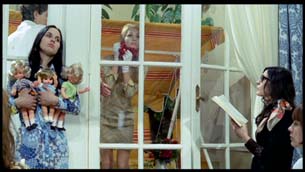
The scene directly cuts back to the villa and a similar vivid color scheme/design pattern to make the visual link that the villa is in its own way a home for the insane.

At a little past the half hour mark a third guest arrives, the man from the opening scene, Pascal, returning to the scene of his incarceration after serving a 13 year prison term. Sancho’s Pascal makes a great villain with his larger than life persona, brash self-confidence, and sense of irony (when he arrives he introduces himself as “Pascal…like the philosopher!”). While in prison he learned about the gangster André’s exploits and now plans to extort $200,000 from the family. Although they eventually kill Pascal too, he proves a tougher egg to crack (as he says, “I wasn’t in jail for 13 years for nothing…I’m a specialist!”) and imposes himself as the unruly house guest from hell. He makes love to both Lucille and Falesse in front of Colin –his Passion Play, as he refers to it– and then beats up Colin when his anger over Pascal shooting one of his pet vultures gets the better of him and he attacks Pascal. Lucille draws on her past as a Nazi Concentration camp survivor to kill Pascal: “Cyanide…it did a real thorough job the first time I watched it.” This cues the first of several jarringly realistic, black & white flashbacks to a scene where she and a group of about a dozen nude women are led to a gas chamber. She is spared, forced to watch through the glass window as her mother, sister and other friends are gassed to death while the Nazi’s look on with sadistic/sexual glee. There’s little doubt that the scene functions at the exploitation level through its justification of female nudity, but, unlike the asylum scene, the women here represent a range of different body types and ages. It is jarring because the stylization is closer to documentary realism (black & white, zoom shots, minimal sets, high contrast lighting) than the pop art/surreal style of the rest of the film.
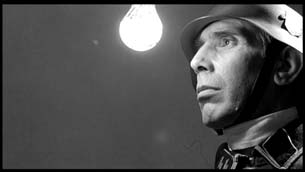
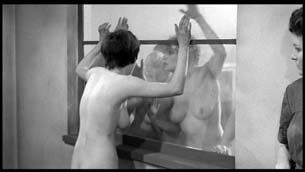
Pascal gets his own form of a Nazi gas treatment during a bubble bath. As the gregarious Pascal enjoys the soap lathers, a close-up reveals a cuckoo clock on the wall above the tub. Two cyanide pills are resting on a ledge outside the clock’s tiny trapdoor. As the clock chimes a toy bird pushes forward the door, dropping the pills into the tub and burning Pascal to death. From the point of the first Nazi flashback onwards Lucille begins to dress, act, and look like a Nazi. She begins to wear a grey shirt and sweater, has her hair pulled back tightly, talks and walks stiffly, and grins sadistically while Pascal dies in the tub.

Colin cements the Nazi comparison when he describes their actions using Nazi terminology. He impresses on Falesse that she is nothing more than a human praying mantis, attracting and destroying her mates: “You have a little fun, then all of a sudden they all wind up dead. It’s a regular ritual. You create the problem and our job is the final solution. We’re experts at it.”
Each new male intruder at the villa is a more difficult prospect for Lucille and company, from Michel, to Alex, to Pascal. The crazy family meets its match with the next male intruder, the elderly man from the asylum scene who arrives on a yacht introducing himself as Lucille’s apparently dead husband André. He claims that he faked his death and laid low for the past thirteen years forging a new identity with the aid of plastic surgery as Derrick. That Lucille is not too surprised by this revelation is a cue that her original version of the story was a lie. When Falesse is introduced to André she is shocked and resists the notion of him being her father: “He’s dead….I killed him 13 years ago!” Lucille recounts yet another version of the primal scene which accounts for this new information. On that fateful night a hit man entered their home to kill André. André eluded the gunshots and escaped through the window. The hit man took out his anger on Lucille and began to attack her. Falesse, drawn to the bedroom by the sound of the gunshots, instinctively saves her mother from the attacker by drawing a sword from the wall and decapitating the hit man (who she mistakes for her father). From that point on Falesse believed she had killed her father.
Alfredo/André/Derrick introduces yet another piece to the puzzle when he asks Colin about the whereabouts of Lucille’s daughter and Colin’s sister, Ester. In another photo freeze frame flashback Lucille recounts how Ester was killed in a car accident four months after he left. They visit her gravesite but André remains unconvinced and asks Lucille about the true whereabouts of his daughter Falesse. In yet another variation on the flashback Lucille switches the story to say that Ester went crazy after the father’s apparent death and was placed in a psychiatric hospital. We cut back to the asylum and a close-up of a young blond-haired woman laughing uncontrollably. André forces the issue and insists that the real Falesse is in the asylum and that she be brought to the villa as its rightful owner. While all of the incriminating evidence/truth is being revealed Colin has André lined up in his rifle view from an upstairs window, but, ever the artiste, he refuses such a pedestrian form of death, telling Falesse: “It is much too vulgar, not my style.”
The real Falesse arrives at the villa, accompanied by a female doctor. Falesse gingerly walks around the villa grounds glancing at Lucille, Colin and the faux Falesse, stopping at a set of swings, which triggers another set of memory flashbacks. With an angelic child-voiced humming reminiscent of the later Suspiria soundtrack, we cut from the present action of Falesse being pushed on the swings by André, to her younger self being pushed on the same set of swings by Antoine, the hit man from the primal scene flashbacks. Back in the present Falesse asks what happened to Antoine, and Lucille curtly replies that no one knows where he is, that he went away. In a second ‘swings’ triggered flashback we see, for the first time, a second, dark-haired daughter playing with Falesse, Ester. These flashback scenes reveal two more plot points: Lucille was intimate with Antonio, and Antoine may have had sexual relations with the young Falesse; and we learn the extent of André’s criminality when we see him framed through the window torturing a man tied to a chair. As Lucille realizes that the truth is beginning to dawn on the faux Falesse, she tells her that she is not André’s daughter Falesse, but her daughter Ester from her first marriage. This shocking revelation is punctuated giallo style with a series of swish pans and jump cut zoom-ins to Ester’s shocked expression. With the revelation that Falesse is actually his blood sibling Ester, Colin begins to laugh at the absurd realization that he has had incestuous relations with his full blood sister! Ester and Colin now force Lucille to come clean with the full truth. She complies by smashing a plant vase that unearths (sorry) the decapitated head of Antonio, which seems to shock Falesse out of her stupor. In this updating of the primal scene we begin with the sound and image of the train which passed by the villa on that fateful night. The dark haired girl, Ester, is now fighting off Antoine and Lucille is the one who decapitates him. The female doctor from the asylum explains how the shock Ester received “caused a switch in personality” (a sorting of threads which echoes the end of Psycho). Ester removes her blond wig and makes a heartfelt pardon to Falesse which is the sort of inappropriate dialogue Eurocult fans have come to love: “I’m sorry I took your place, but I really had no idea I wasn’t you!”
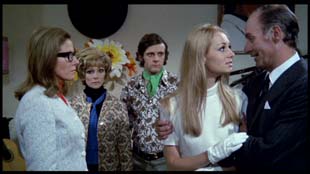
André now admits to Lucille that he knew about her affair with Antoine and how she used him in “Postman Always Rings Twice” fashion to get him to kill André so that she would inherit his estate. With this new twist the film partially enters into the profit/greed motif of killing. In fact In the Folds of the Flesh is an unusual merging of the two most commonly used reasons for murders in the giallo: profit or psycho-sexual. With her devious plot revealed, Lucille has nothing left to live for and commits suicide by cyanide (the suicide is precipitated by a final ‘death’ montage of the earlier deaths and more concentration camp footage). Just when you thought you could begin to unravel all the knots in your brain, the film offers yet a final twist: André is in fact police inspector Alfredo, as were the previous ‘victims’ Michel and Alex. (When asked about the murdered Michel and Alex the inspector glibly says, “They’re history now…one of the risks of the job.”). Alfredo adds that André died in prison three years ago, but asked the police to look after his daughter Falesse. Falesse seems to be on the road to a full recovery, and is restored as the rightful owner of the estate. Colin and Ester are driven away by the police, arrested we presume. A rare happy ending, at least for a giallo.
With a mixed stew of incest, sadism, cheap Freudianism, and an out of the blue, hard edged Nazi back-story, In the Folds of the Flesh is an odd beast of a giallo. While in the giallo ‘crazy family/insane woman’ mold (which includes such titles as Your Vice is a Locked Door and Only I Have the Key, All the Colors of the Dark, The Night Evelyn Came Out of the Grave, and The Perfume of the Lady in Black) it looks ahead to the Nazi exploitation film, recalls the spaghetti western through western stalwart Fernando Sancho’s performance, and mixes in elements of the later 1970s crime film (the ‘poliziottesco’) through André’s back-story. The film goes one step further than most gialli in another respect: the gender of the killer. Gialli are known for mixing things up when it comes to the gender of the killer. Whereas in most American serial killer or slasher films the killer is male, in a giallo women are just as likely to be murderers as men. And in other cases, transsexuals or transvestites. The giallo plays no favorites when it comes to the murderer. In this film every murder involves a woman as the perpetrator, either alone or in union with Colin (with the telling exception of the Nazi flashback scenes, adding yet another layer of realism to those scenes). And each subsequent victim takes just that much longer to kill. The first ‘cousin’ Michel is dispatched by Falesse on their first sexual encounter the night of his arrival. His mustachioed friend Alex survives Falesse’s first attack but not the second. And the burly criminal from the opening prologue, Pascal, holds court over them for a few scenes before a cyanide bath does him in.
Severin Films has thankfully made this difficult to find oddity finally available in North America in a wonderful, near-pristine 1.85 anamorphic DVD transfer. The only complaints being a couple of day for night scenes that were not properly transferred, resulting in scenes that are supposed to be played at night coming across as day time scenes. The worse case is the scene where Pascal forces them to dig for André’s corpse; we hear crickets but see a clear blue sky above. 2 I realize that because of the international nature of Italian films of this era (this is an Italian-Spanish co-production, featuring Italian and Spanish actors) all films at this time were shot silent with language dubbed in for the appropriate markets. Since some of the principal actors are Italian (Anna Maria Pierangeli as Falesse/Ester, Eleonora Rossi Drago as Lucille), I would have preferred having an Italian audio option to supplement the English only audio selection. While Severin is renown for its plentiful special features this one, sadly, comes only sporting a trailer; but the rarity of this title, along with the quality of the transfer, should make fans ecstatic that the film is finally available for home viewing. The DVD can be purchased directly from the Severin website, or from any amazon dealer.
Notes
- In the giallo the punctum is an action which a protagonist unwittingly witnesses and which involves a murder or attempted murder. The seeing of the act draws the character into the case, often at serious risk. The character may become obsessed with solving the case, turning him/her into an amateur detective. What makes the initial ‘primal scene’ a punctum is that the character turns to memory to help sort out the potential clues that are visible but hidden from obvious view. The film often cuts back to subjective flashes of the event, as the character tries to piece together the clues. The French literary critic Roland Barthes introduced the term in his book on photography, Camera Lucida: “There are two kinds of punctum. The first is that which is “that accident which pricks, bruises me” (Barthes, p. 26). It is the unintentional detail that could not not be taken, and that “fills the whole picture.” (Barthes, p. 45) Sometimes, the punctum reveals itself after the fact, as a function of memory. (Barthes, p. 53) It is a testament to the pensiveness of a photograph, comprising the part of the photo that is it at its strongest when one is not looking at the photograph. Summary: Camera Lucida. Accessed Dec. 1, 2005. “The punctum, on the other hand, is the detail that catches the eye, jogs the memory, arouses tenderness. The punctum has the power of expansion, while remaining a detail.” Elsa Dorfman. Review of Camera Lucida. Accessed Nov. 25, 2005. ↩
- It is impossible to be sure about who is at fault for the unconvincing day for night scenes: the original film or the DVD transfer. My guess is the latter, though I am willing to be proven wrong if someone can offer definitive evidence. ↩



